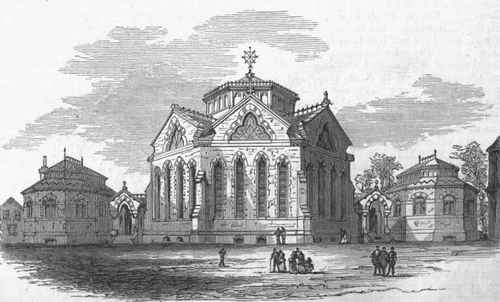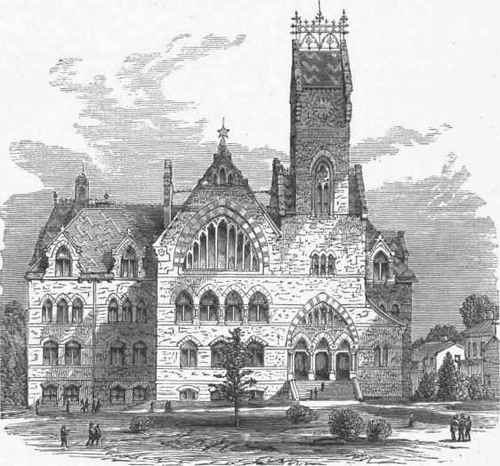Princeton
Description
This section is from "The American Cyclopaedia", by George Ripley And Charles A. Dana. Also available from Amazon: The New American Cyclopędia. 16 volumes complete..
Princeton
Princeton, a township and town of Mercer co., New Jersey, at the terminus of a branch (3 m. long) of the Pennsylvania railroad, 40 m. N. E. of Philadelphia, and 11 m. N. E. of Trenton; pop. in 1870, of the township, 3,986; of the town, 2,798. The town is neatly built and pleasantly situated, and contains a number of elegant residences. It has a bank, two hotels, two public and several private schools, a weekly newspaper, and nine churches, besides the chapels of the college and seminary. The continental congress met here June 30, 1783. - Princeton is the seat of the college of New Jersey, popularly called Princeton college, and of the theological seminary of the Presbyterian church. The college of New Jersey was founded under the auspices of the Presbyterian synod of New York, which then included New Jersey under its jurisdiction. It obtained a charter in 1746, and a more liberal one in 1748. It was opened in May, 1747, at Elizabethtown (now Elizabeth), and the same year was removed to Newark, whence it was transferred to Princeton in 1757, upon the completion of 'a college edifice, which at the suggestion of Gov. Belcher was named Nassau hall, "to the immortal memory of the glorious King William the Third," "of the illustrious house of Nassau." From this circumstance the college itself is often called Nassau Hall. It suffered greatly in the war of the revolution, and the main building was occupied as a barrack and a hospital both by the American and the British troops.
Gen. Washington drove a detachment of British soldiers from its walls at the battle of Princeton, Jan. 3, 1777. (See Princeton, Battle of.) Dr. Witherspoon and two of the alumni, Richard Stockton and Benjamin Rush, were signers of the Declaration of Independence. The continental congress and Gen. Washington were present at the commencement in 1783. Gen. Washington presented 50 guineas to the college to repair the building, but the trustees appropriated the sum to the painting of a portrait of Washington by the elder Peale. It is said to occupy the frame which once held the portrait of George II., destroyed by a cannon ball in the battle of Princeton. After the revolution, by dint of great effort, means were obtained to repair the buildings and pay the salaries. Nassau hall was destroyed by fire, March 6, 1802. Funds were collected from friends in the middle and southern states, and the college was rebuilt, and two other buildings were erected for lectures and recitations. Nassau hall was again burned March 10, 1855. The old walls still remained, and it was speedily rebuilt, only slightly modified. The civil war affected the number of the students and the funds of the institution very seriously, but friends contributed liberally to its wants.
After the close of the war the number of students gradually increased, and on the resignation of Dr. Maclean in 1868 the institution was in a prosperous condition. Dr. Maclean was succeeded in the presidency by the Rev. Dr. James McCosh, of Belfast, Ireland. His administration has been distinguished by great energy and activity, and his high reputation has added much to the college in every way. The faculty has been enlarged, the number of students increased, new departments of study have been added, many fine buildings erected, and the funds greatly increased. Among the benefactors of the college may be named Messrs. James Lennox, John I. Blair, N. Morris Halsted, John 0. Green, Henry G. Marquand, and Robert Bonner. Mr. Green has given not less than $750,000 to endow a scientific school, erect a library and a building for lectures and recitations, and for other objects. More than $1,000,000 have been given to the college since Dr. McCosh became president. The presidents of the college have been as follows:

Library of the College of New Jersey.
NAME. | Term. |
Rev.Jonathan Dickinson... | May to Oct., 1T47. |
Rev.Aaron Burr.... | 1748-1757. |
Rev.Jonathan Edwards..... | Jan. to Mar., 1758. |
Rev. Samuel Davies..................... | 1759-1761. |
Rev. Samuel Finley..................... | 1761-1766. |
Rev.Dr.John Witherspoon.... | 1768-1794. |
Rev.Dr.Smual Stanhope Smith.... | 1795-1812. |
Rev.Dr.Ashbel Green.... | 1812-1822. |
Rev.Dr.James Carnahan.... | 1823-1854. |
Rev. Dr.John Maclean.... | 1854-1868. |
Rev.Dr.James MaCosh.... | 1868- |
The college year is divided into three terms. All the studies of the freshman and sophomore years are required; in the junior and senior years a considerable range of elective studies is provided. There are a number of prizes and scholarships obtainable by deserving students. Six fellowships have been established, four of which yield $600 each, the other two yielding $250 each. These are conferred after examination upon members of the graduatiug class, and the recipients are required to pursue a course of studies for one year in the department for which the fellowship was granted, under the superintendence of the faculty. There is a preparatory school connected with the college. The John O. Green school of science was opened in 1873. It has a course of two years for graduates of colleges, on the completion of which the degree of master of science is conferred, and a course of three years for others, on the completion of which the degree of bachelor of science is conferred. Special courses may also be pursued.
In 1874-'5 there were in the college 14 professors, 6 other instructors, and 408 students, of whom 25 were in the school of science and 383 in the academic department, viz.: fellows, 7; seniors, 77; juniors, 113; sophomores, 97; freshmen, 89. The college and society libraries contain 55,000 volumes. The whole number of graduates is about 4,850, of whom nearly 2,750 survive. Among the graduates have been some of the most distinguished men both in church and in state. The various endowments amount to about $600,000. The college buildings are mostly of stone, and occupy the campus, running parallel with the main street of the town. The grounds are well shaded with trees. A quadrangle is formed by Nassau hall on the north, Reunion and "West college halls on the west, East college on the east, and the halls of the literary societies on the south. The Phila-delphian society's hall and the president's residence are nearer the street. E. of Nassau hall is the elegant new library building; beyond this is Dickinson hall; and at the E. end of the line stands the new and handsome building of the school of science. The gymnasium and the Hal-sted observatory are near the railroad depot. - The theological seminary, founded in 1812, occupies several plain stone buildings near the college.
The regular course is three years, with a post-graduate course of one year. In 1874-'5 there were 6 professors, 1 tutor, and 116 students, viz.: resident graduates, 2; senior class, 32; middle class, 35; junior class, 47. The whole number of graduates is nearly 3,100, of whom about 2,300 survive. The number of volumes in the library is 24,000. The endowment amounts to $400,000.

School of Science.
Continue to:


